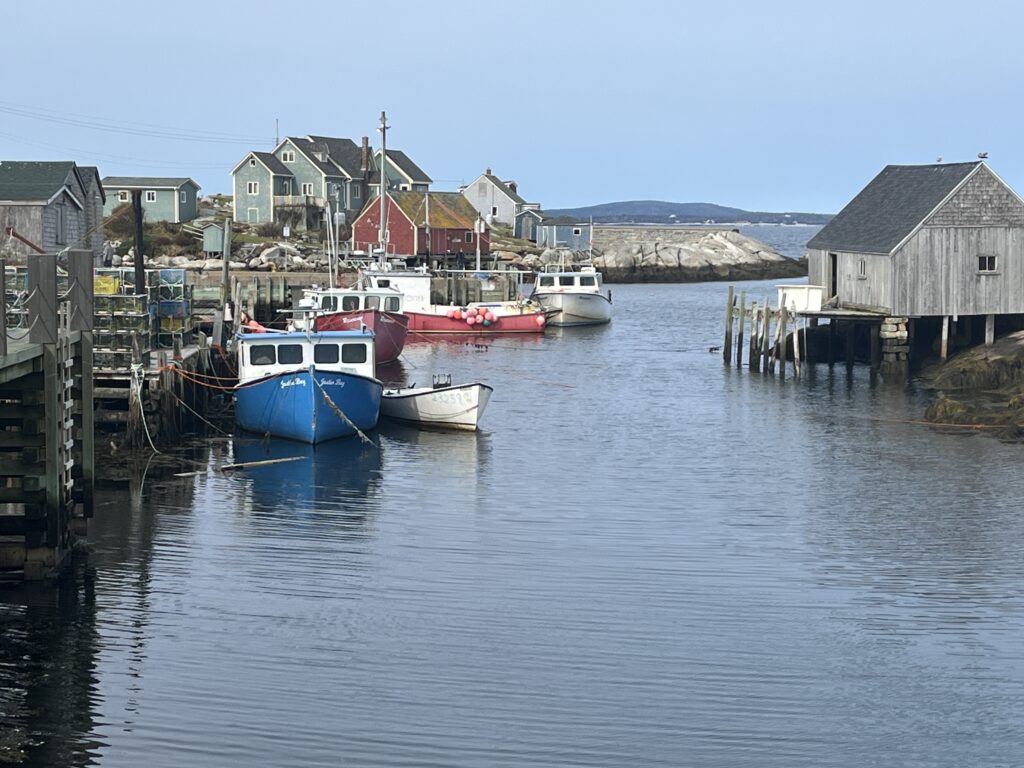Nova Scotia in Latin means New Scotland, and is reflective of the origins of the early settlers. It is the second smallest province in Canada and includes a large island called Cape Breton northeast of the mainland. It is often said that both the landscape and the climate are comparable to those of Scotland. We spent two wonderful weeks touring this province of rolling hills, forests, countless rivers and lakes, cliffs, and beaches.
After catching the ferry from PEI, we drove to Cape Breton to begin our tour of Nova Scotia in the small town of Baddeck. We had a slight disruption of our schedule as Hurricane Lee decided swing up the coast in the direction of the Canadian Maritimes. We escaped without any significant winds but did catch a lot of rain as it passed by. It put a slight “damper” on our hiking plans but we decided to visit some local restaurants and seafood markets for their freshly caught fish and seafood chowders. We also visited the Alexander Graham Bell historical museum that was fascinating and the perfect way to while away a rainy afternoon. In the evening, we took in a local community play. It called the Hydrofoil Mystery and was based one of his more interesting Alexander Bell inventions and kept us very entertained. Another evening found us at a traditional Scottish gathering (ceilidh), listening to some fantastic Celtic music by some very talented locals on fiddle and guitar. We were served some authentic oatcakes accompanied by hot tea (of course served in porcelain mugs) at intermission. We loved it! Although the weather did limit our outdoor activities for a few days, we did get out to drive the most scenic sections of the Cabot Trail and hiked the Skyline Trail which offered gorgeous views of the coastline.
We were sorry to leave Cape Breton and Baddeck, but moved on to our next stop near Lunenburg situated along the southern coast of NS. From our home base we visited several small towns nearby that were unbelievably picturesque and so colorful! The Victorian homes near the wharf in Lunenberg were amazing. The Fisheries Museum of the Atlantic was wonderful and well worth the visit. We were able to tour a restored schooner called the Theresa E. Connor. As luck would have it, we were the only ones on the boat at the time and had an engrossing conversation with a docent who spent 45 years at sea as a local fisherman. It was a very hard life, and while conditions have improved, it did give us a new appreciation for the grueling work involved in getting delicious cod, halibut, and haddock to our dinner table.
There were so many quaint towns but one of our favorites was Mahone Bay, only a few miles from our campground. There was a fall “Scarecrow Festival” with funny, creative life-sized mannequins all over town. We also spent a fair amount of time watching hand crafting of beautiful pewter ornaments and jewelry. The coastal drive also included the Blue Rocks and a stop in Peggy’s Cove (population 37 with 700,000 visitors annually). Peggy’s Cove was stunning with its lighthouse, charming houses/boats and rocky shoreline and is one of the most photographed areas in Canada. Our visit was accompanied by Scottish bagpipe music to add to the ambience. A couple of hikes Kejimkujik National Park offered its own lovely vistas along the river and falls.
Our last stop was along the northwestern coastal area of the Bay of Fundy. The tide changes here are the largest in the world and Burntcoat Park was the place to see evidence of those changes. It was mind boggling to see the shoreline with its high cliffs and red seabed. The tide can come in at 10 mph generating high waves and rapids. No Beamish/Hereford travel schedule would be complete without a trip to several of the local wineries. We did some sampling of the wines and had a tasty lunch overlooking the beautiful vineyards and delightful gardens. Our last stop was a trek to the town of Digby, home of the best of arguably the best scallops in the world. Unfortunately, the fisherman had all caught their quotas by the end of August and could not go out again for another week in October. We did get some lovely photos of all of the fishing boats and picked up some frozen-at-sea “famous” scallops. They were scrumptious, of course, and worth the drive to get them. A fun and delicious ending to a fabulous trip to Nova Scotia.






















































Beautiful pictures! You both look great! Looking through your pictures and reading your blogs gives us ideas on where to travel to next!
Thanks, Freda. It would be great together when we’re back in town.